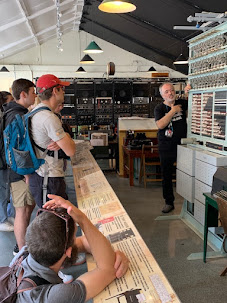Congratulations to our 2022 class of the Engineering in London (EIL) study abroad program! Photos from the banquet dinner at Brown's of Covent Garden
on Friday, July 8 are provided below. Click here for the final slideshow of the program edited by Mara Schutt.
Friday, July 8, 2022
Banquet at Brown's in Covent Garden
Tuesday, July 5, 2022
Royal Institution (Faraday Laboratory)
On Tuesday evening, July 5, the EIL Students along with Profs. Berry
and Aaron visited the Royal Institution (Michael Faraday Museum) near
Green Park. In addition to visiting Faraday's Laboratory, the students
attended a (Friday) Discourse lecture entitled "Einstein's revolution: Technology for the 21st Century quantum computer" by Professor David Jamieson (University of Melbourne, Australia). His lecture was given in the Royal institution's lecture
hall, where Michael Faraday started the Christmas lectures in 1825. The
RI today is known for its science education programs, a continuation of
the tradition of scientific lectures as enlightened entertainment. The
Friday Night Discourses were formal affairs with the audience in evening
dress and the speaker by tradition had to start and stop his address as
the auditorium clock struck consecutive hours. J. J. Thomson announced
the discovery of the electron in his 1897 lecture in this room. The
Christmas Lecture program, begun by Michael Faraday and continuing
through today, is the oldest continuous science education program for
young people.
Monday, July 4, 2022
Brunel Museum
On Monday afternoon (July 4), the EIL students joined Profs. Berry
and Aaron for a visit to the Brunel Museum at Rotherhithe on
the bank of the
Thames River. In the original shaft of the tunnel (under the Thames
River) that Marc and Isambard (Kingdom) Brunel designed and built, our
guide (Khalil Mohammed) gave an excellent historical timeline for this great nineteenth
century engineering achievement. Completed in 1834, this was the
world's first underwater tunnel. Isambard Brunel was considered by many
to be the greatest engineer of Victorian England.
Friday, July 1, 2022
Bletchley Park
On a somewhat chilly Friday, July 1, the EIL students along with Profs. Berry and Aaron and Rohima Ahmed from IES visited Bletchley Park (north of London). Bletchley Park is where Alan Turing and his colleagues in Hut 8 broke the (naval) Enigma code during World War II. The students witnessed demonstrations of working Enigma, Bombe, Tunny, Harwell Dekatron, and Colossus machines. The Colossus was the world's first electric digital computer that was programmable. The Colossus computers were developed to help in the cryptanalysis of the Hitler's Lorenz cipher. Nicknamed WITCH for Wolverhampton Instrument for Teaching Computing from Harwell, the Harwell Dekatron at the National Museum of Computing (NMC) is considered the oldest electronic computer that is still operational. Our NMC guide for the morning, Robert Dowell, did a fantastic job explaining both the history and design of all the early cypher and computing machines. The students utilized part of their lunch break to burn off some energy on the jungle gym equipment and with a game of ultimate frisbee near the Bletchley Park Mansion.
Thursday, June 30, 2022
Old Operating Theatre and Herb Garret
On Thursday June 30, the EIL students (composed of several Biomedical Engineering majors) along with Profs. Berry and Aaron visited the Old Operating Theatre and Herb Garret on St. Thomas Street (between The Shard and Borough Market). Housed in the attic of the early eighteenth-century church of the old St
Thomas’ Hospital, this atmospheric museum offers a unique insight into
the history of medicine and surgery. The original timber framed Herb
Garret was once used to dry and store herbs for patients’ medicines and
in 1822 an operating theatre was included. Predating anaesthetics and
antiseptics, it is the oldest surviving surgical theatre in Europe.
Wednesday, June 29, 2022
British Science Museum (South Kensington)
On Wednesday, June 29, the EIL students visited the British Science Museum in South Kensington. They were able to see several Boulton and Watt Steam Engines and Babbage's Difference Engine (Models 1 and 2). Professors Berry and Aaron awarded trivia winners with candy afterwards. The group photo (with EIL banner) is taken in front of the 1903 Mill Engine manufactured by Burnley Ironworks Co. At the invitation of Gareth Jones, Lead Engineering Technician for the museum, and his Tech Team, the students witnessed the startup of this particular steam engine (that ran for about an hour). This sophisticated 700-horsepower engine was installed in the Harle Syke Mill, near Burnley, Lancashire, in 1903. It powered hundreds of looms in the mill, via belts driven by the huge 20-tonne flywheel. The mill was dismantled in 1970 and moved to the museum in 1979.
Thursday, June 23, 2022
Greenwich
On Thursday, June 23, the EIL students along with Profs. Berry and Aaron took an Uber boat up the Thames River to Greenwich. At Greenwich, they visited the Cutty Sark ship, Royal Maritime Museum, the Queen's House, and the Royal Observatory. In the Time and Longitude Gallery of the Flamsteed House at the Royal Observatory, students were able to see the four Harrison's sea clocks from the eighteenth century. Harrison's H4 clock is considered the most important timekeeper ever made. It is the machine that helped solve the problem of keeping accurate time at sea and finally won Harrison huge rewards from the Board of Longitude and the British Government. As is customary, group photos were taken at the Prime Meridian (Longitude 0) and with Southeast London as the background. After lunch, several students and the faculty played ultimate frisbee and competed in a sprint. The final excursion of the day was a short bus ride to the Thames Barrier, just north of the Greenwich Town Centre. Operated by the Environment Agency of the British government, the Thames Barrier is one of the largest movable flood barriers in the world.




























































